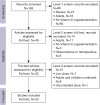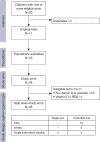A pilot validation study of crowdsourcing systematic reviews: update of a searchable database of pediatric clinical trials of high-dose vitamin D
- PMID: 28164026
- PMCID: PMC5253266
- DOI: 10.21037/tp.2016.12.01
A pilot validation study of crowdsourcing systematic reviews: update of a searchable database of pediatric clinical trials of high-dose vitamin D
Abstract
Background: Completing large systematic reviews and maintaining them up to date poses significant challenges. This is mainly due to the toll required of a small group of experts to screen and extract potentially eligible citations. Automated approaches have failed so far in providing an accessible and adaptable tool to the research community. Over the past decade, crowdsourcing has become attractive in the scientific field, and implementing it in citation screening could save the investigative team significant work and decrease the time to publication.
Methods: Citations from the 2015 update of a pediatrics vitamin D systematic review were uploaded to an online platform designed for crowdsourcing the screening process (http://www.CHEORI.org/en/CrowdScreenOverview). Three sets of exclusion criteria were used for screening, with a review of abstracts at level one, and full-text eligibility determined through two screening stages. Two trained reviewers, who participated in the initial systematic review, established citation eligibility. In parallel, each citation received four independent assessments from an untrained crowd with a medical background. Citations were retained or excluded if they received three congruent assessments. Otherwise, they were reviewed by the principal investigator. Measured outcomes included sensitivity of the crowd to retain eligible studies, and potential work saved defined as citations sorted by the crowd (excluded or retained) without involvement of the principal investigator.
Results: A total of 148 citations for screening were identified, of which 20 met eligibility criteria (true positives). The four reviewers from the crowd agreed completely on 63% (95% CI: 57-69%) of assessments, and achieved a sensitivity of 100% (95% CI: 88-100%) and a specificity of 99% (95% CI: 96-100%). Potential work saved to the research team was 84% (95% CI: 77-89%) at the abstract screening stage, and 73% (95% CI: 67-79%) through all three levels. In addition, different thresholds for citation retention and exclusion were assessed. With an algorithm favoring sensitivity (citation excluded only if all four reviewers agree), sensitivity was maintained at 100%, with a decrease of potential work saved to 66% (95% CI: 59-71%). In contrast, increasing the threshold required for retention (exclude all citations not obtaining 3/4 retain assessments) decreased sensitivity to 85% (95% CI: 65-96%), while improving potential workload saved to 92% (95% CI: 88-95%).
Conclusions: This study demonstrates the accuracy of crowdsourcing for systematic review citations screening, with retention of all eligible articles and a significant reduction in the work required from the investigative team. Together, these two findings suggest that crowdsourcing could represent a significant advancement in the area of systematic review. Future directions include further study to assess validity across medical fields and determination of the capacity of a non-medical crowd.
Keywords: Crowdsourcing; citation screening; systematic reviews; vitamin D.
Conflict of interest statement
The authors have no conflicts of interest to declare.
Figures



Similar articles
-
Successful incorporation of single reviewer assessments during systematic review screening: development and validation of sensitivity and work-saved of an algorithm that considers exclusion criteria and count.Syst Rev. 2021 Apr 5;10(1):98. doi: 10.1186/s13643-021-01632-6. Syst Rev. 2021. PMID: 33820560 Free PMC article.
-
Crowdsourcing the Citation Screening Process for Systematic Reviews: Validation Study.J Med Internet Res. 2019 Apr 29;21(4):e12953. doi: 10.2196/12953. J Med Internet Res. 2019. PMID: 31033444 Free PMC article.
-
Crowdsourcing citation-screening in a mixed-studies systematic review: a feasibility study.BMC Med Res Methodol. 2021 Apr 26;21(1):88. doi: 10.1186/s12874-021-01271-4. BMC Med Res Methodol. 2021. PMID: 33906604 Free PMC article.
-
An exploration of crowdsourcing citation screening for systematic reviews.Res Synth Methods. 2017 Sep;8(3):366-386. doi: 10.1002/jrsm.1252. Epub 2017 Jul 4. Res Synth Methods. 2017. PMID: 28677322 Free PMC article.
-
Crowdsourcing in health and medical research: a systematic review.Infect Dis Poverty. 2020 Jan 20;9(1):8. doi: 10.1186/s40249-020-0622-9. Infect Dis Poverty. 2020. PMID: 31959234 Free PMC article.
Cited by
-
Co-occurrence of Asthma and the Inflammatory Bowel Diseases: A Systematic Review and Meta-analysis.Clin Transl Gastroenterol. 2018 Sep 24;9(9):188. doi: 10.1038/s41424-018-0054-z. Clin Transl Gastroenterol. 2018. PMID: 30250122 Free PMC article.
-
Successful incorporation of single reviewer assessments during systematic review screening: development and validation of sensitivity and work-saved of an algorithm that considers exclusion criteria and count.Syst Rev. 2021 Apr 5;10(1):98. doi: 10.1186/s13643-021-01632-6. Syst Rev. 2021. PMID: 33820560 Free PMC article.
-
Crowdsourcing the Citation Screening Process for Systematic Reviews: Validation Study.J Med Internet Res. 2019 Apr 29;21(4):e12953. doi: 10.2196/12953. J Med Internet Res. 2019. PMID: 31033444 Free PMC article.
-
Pediatric Chronic Critical Illness: Protocol for a Scoping Review.JMIR Res Protoc. 2021 Oct 1;10(10):e30582. doi: 10.2196/30582. JMIR Res Protoc. 2021. PMID: 34596576 Free PMC article.
-
Conservative and surgical modalities in the management of paediatric parapneumonic effusion and empyema: a protocol for a living systematic review and network meta-analysis.BMJ Open. 2021 Mar 24;11(3):e045010. doi: 10.1136/bmjopen-2020-045010. BMJ Open. 2021. PMID: 33762243 Free PMC article.
References
-
- Pearson A, Wiechula R, Court A, et al. The JBI model of evidence-based healthcare. Int J Evid Based Healthc 2005;3:207-15. - PubMed
-
- Martin A, Saunders DH, Shenkin SD, et al. Lifestyle intervention for improving school achievement in overweight or obese children and adolescents. Cochrane Database Syst Rev 2014;(3):CD009728. - PubMed
-
- Lavoie MC, Verbeek JH, Pahwa M. Devices for preventing percutaneous exposure injuries caused by needles in healthcare personnel. Cochrane Database Syst Rev 2014;(3):CD009740. - PubMed
LinkOut - more resources
Full Text Sources
Other Literature Sources
Research Materials
Miscellaneous
